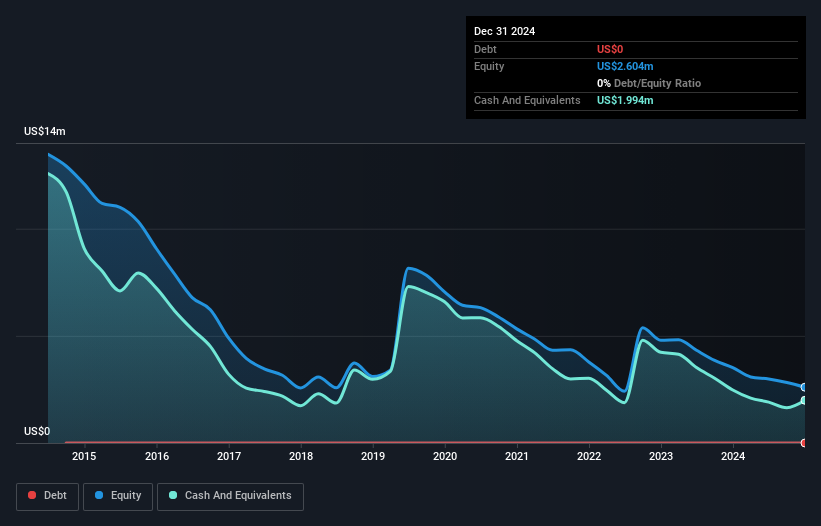Companies Like Research Frontiers (NASDAQ:REFR) Can Afford To Invest In Growth
Just because a business does not make any money, does not mean that the stock will go down. For example, biotech and mining exploration companies often lose money for years before finding success with a new treatment or mineral discovery. But the harsh reality is that very many loss making companies burn through all their cash and go bankrupt.
So should Research Frontiers (NASDAQ:REFR) shareholders be worried about its cash burn? For the purpose of this article, we'll define cash burn as the amount of cash the company is spending each year to fund its growth (also called its negative free cash flow). The first step is to compare its cash burn with its cash reserves, to give us its 'cash runway'.
This technology could replace computers: discover the 20 stocks are working to make quantum computing a reality.
When Might Research Frontiers Run Out Of Money?
A cash runway is defined as the length of time it would take a company to run out of money if it kept spending at its current rate of cash burn. When Research Frontiers last reported its December 2024 balance sheet in March 2025, it had zero debt and cash worth US$2.0m. In the last year, its cash burn was US$790k. So it had a cash runway of about 2.5 years from December 2024. That's decent, giving the company a couple years to develop its business. The image below shows how its cash balance has been changing over the last few years.

See our latest analysis for Research Frontiers
How Is Research Frontiers' Cash Burn Changing Over Time?
Whilst it's great to see that Research Frontiers has already begun generating revenue from operations, last year it only produced US$1.3m, so we don't think it is generating significant revenue, at this point. As a result, we think it's a bit early to focus on the revenue growth, so we'll limit ourselves to looking at how the cash burn is changing over time. Notably, its cash burn was actually down by 66% in the last year, which is a real positive in terms of resilience, but uninspiring when it comes to investment for growth. Of course, we've only taken a quick look at the stock's growth metrics, here. You can take a look at how Research Frontiers is growing revenue over time by checking this visualization of past revenue growth .
How Easily Can Research Frontiers Raise Cash?
There's no doubt Research Frontiers' rapidly reducing cash burn brings comfort, but even if it's only hypothetical, it's always worth asking how easily it could raise more money to fund further growth. Issuing new shares, or taking on debt, are the most common ways for a listed company to raise more money for its business. Many companies end up issuing new shares to fund future growth. By comparing a company's annual cash burn to its total market capitalisation, we can estimate roughly how many shares it would have to issue in order to run the company for another year (at the same burn rate).
Research Frontiers has a market capitalisation of US$34m and burnt through US$790k last year, which is 2.3% of the company's market value. So it could almost certainly just borrow a little to fund another year's growth, or else easily raise the cash by issuing a few shares.
Is Research Frontiers' Cash Burn A Worry?
It may already be apparent to you that we're relatively comfortable with the way Research Frontiers is burning through its cash. In particular, we think its cash burn relative to its market cap stands out as evidence that the company is well on top of its spending. And even its cash runway was very encouraging. After taking into account the various metrics mentioned in this report, we're pretty comfortable with how the company is spending its cash. An in-depth examination of risks revealed 2 warning signs for Research Frontiers that readers should think about before committing capital to this stock.
Of course, you might find a fantastic investment by looking elsewhere. So take a peek at this free list of companies with significant insider holdings, and this list of stocks growth stocks (according to analyst forecasts)
New: AI Stock Screener & Alerts
Our new AI Stock Screener scans the market every day to uncover opportunities.
• Dividend Powerhouses (3%+ Yield)• Undervalued Small Caps with Insider Buying• High growth Tech and AI CompaniesOr build your own from over 50 metrics.
Explore Now for FreeHave feedback on this article? Concerned about the content? Get in touch with us directly. Alternatively, email editorial-team (at) simplywallst.com.This article by Simply Wall St is general in nature. We provide commentary based on historical data and analyst forecasts only using an unbiased methodology and our articles are not intended to be financial advice. It does not constitute a recommendation to buy or sell any stock, and does not take account of your objectives, or your financial situation. We aim to bring you long-term focused analysis driven by fundamental data. Note that our analysis may not factor in the latest price-sensitive company announcements or qualitative material. Simply Wall St has no position in any stocks mentioned.
Disclaimer: Investing carries risk. This is not financial advice. The above content should not be regarded as an offer, recommendation, or solicitation on acquiring or disposing of any financial products, any associated discussions, comments, or posts by author or other users should not be considered as such either. It is solely for general information purpose only, which does not consider your own investment objectives, financial situations or needs. TTM assumes no responsibility or warranty for the accuracy and completeness of the information, investors should do their own research and may seek professional advice before investing.
Most Discussed
- 1
- 2
- 3
- 4
- 5
- 6
- 7
- 8
- 9
- 10